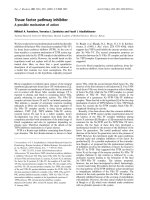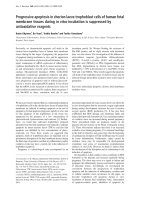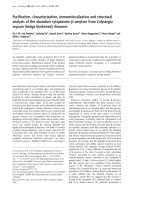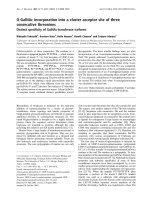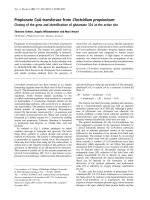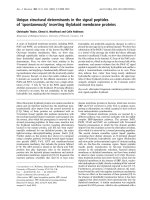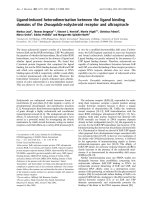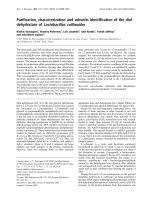Báo cáo y học: "Put your heart into the joint benefits of statins" pps
Bạn đang xem bản rút gọn của tài liệu. Xem và tải ngay bản đầy đủ của tài liệu tại đây (38.6 KB, 3 trang )
202
HMG-CoA = 3-hydroxy-3-methylglutaryl-coenzyme A; IFN = interferon; i.p. = intraperitoneally; LPS = lipopolysaccharide; Th = T helper cell; TNF =
tumour necrosis factor.
Arthritis Research & Therapy Vol 5 No 4 Hall
The recognition that systemic inflammatory diseases are
associated with accelerated atherosclerosis offers the
prospect of reducing morbidity and mortality of affected
patients by attention to traditional cardiovascular risk
factors. For example, in most studies of mortality in
patients with rheumatoid arthritis, excess cardiovascular
deaths predominate, with a risk ratio of about 2 (reviewed
by Van Doornum [1]). Several recent observations indicate
that not only is chronic inflammation associated with ather-
osclerosis but aberrant cellular and humoral immune
responses are integral to its pathogenesis (reviewed by
Sherer and Shoenfeld [2]). It has become apparent that
therapeutic interventions in chronic inflammatory and car-
diovascular disease might be closely intertwined. Also
emerging is the realisation that agents prescribed as
either immunomodulators or lipid modulators might be
acting in both capacities. Statins are particularly topical in
this regard.
Statins (3-hydroxy-3-methylglutaryl-coenzyme A [HMG-
CoA] reductase inhibitors) are widely prescribed for indi-
viduals at increased risk from cardiovascular disease
(reviewed by Singh and Mehta [3]). HMG-CoA reductase
is an enzyme of the cholesterol biosynthetic pathway that
catalyses the conversion of HMG-CoA to mevalonic acid.
Downstream metabolites in this pathway include farnesyl
pyrophosphate and geranylgeranyl pyrophosphate, which
are required for post-translational prenylation of a range of
moieties, including signalling intermediaries, tRNA and
coenzyme Q in the electron transport chain (reviewed in
Holstein et al. [4]). It follows that, in addition to decreasing
cholesterol levels, statins can be expected to have diverse
effects on cell physiology.
In 1995 it was reported that pravastatin decreased the
incidence of haemodynamically significant rejection
episodes in cardiac transplant patients and that this effect
was independent of the decrease in cholesterol levels [5].
Subsequent studies have revealed a wide range of statin-
sensitive immunological pathways. For example, statins
bind to β
2
integrin and thereby block T-cell costimulation
by means of lymphocyte-function-associated antigen-1
(LFA-1) [6]. Statins inhibit interferon-γ-inducible class II
transactivator (CIITA) to decrease the induction/upregula-
tion of MHC class II molecules on professional and non-
professional antigen-presenting cells [7]. In monocytes
and/or macrophages, statins decrease chemotaxis,
lipopolysaccharide (LPS)-mediated release of tumour
necrosis factor-α (TNF-α) activation of NO synthase [8]
and LPS-stimulated secretion of matrix metalloproteinase-
9 [9]. These immunological effects indicate that statins
might interfere with the initiation and amplification of
immune/inflammatory responses. The appeal of statin
therapy in chronic inflammatory disease is further
enhanced by accumulating evidence that statins might
influence bone metabolism (reviewed by Bauer [10]).
Although the observation that statins prevented rejection
episodes after cardiac transplant suggests that significant
immunomodulatory effects can be obtained in vivo, some
subsequent clinical data have been equivocal and most
investigations have demonstrated effects on pathways in
vitro. Oral atorvastatin was recently shown to prevent or
reverse either chronic or relapsing paralysis in a murine
model of demyelination [11]. This was associated with a
shift from T helper (Th)1-type immune responses towards
Th2-type responses in vivo.
Could statins have such impressive effects in a model of
inflammatory arthritis? Leung and colleagues chose the
well-characterised model of collagen-induced arthritis in
the arthritis-susceptible DBA/1j mouse strain, in which
arthritis is induced 25–35 days after immunisation with
bovine type II collagen emulsifed in complete Freund’s
adjuvant [12]. Simvastatin was administered daily at 10, 20
or 40 mg/kg. These doses are higher than those used in
Viewpoint
Put your heart into the joint benefits of statins!
Frances C Hall
ARC Rheumatology Lecturer, Addenbrooke’s Hospital, Cambridge, UK
Corresponding author: Frances C Hall (e-mail: )
Received: 27 May 2003 Accepted: 3 Jun 2003 Published: 11 Jun 2003
Arthritis Res Ther 2003, 5:202-204 (DOI 10.1186/ar788)
© 2003 BioMed Central Ltd (Print ISSN 1478-6354; Online ISSN 1478-6362)
203
Available online />humans because of the relatively rapid induction of HMG-
CoA reductase in rodents [13] and, apparently, even the
administration of 40 mg/kg simvastatin was not associated
with a significant decrease in plasma cholesterol concen-
tration in mice. Both ‘prophylactic’ and ‘therapeutic’ sim-
vastatin regimes were investigated. Prophylactic daily
administration of simvastatin intraperitoneally (i.p.) was
begun 21 days after the initial immunisation with type II col-
lagen/adjuvant; that is, several days before the onset of
arthritis. The therapeutic regime consisted of 40 mg/kg
daily simvastatin i.p. for 14 days, starting on the day after
the onset of arthritis (8–14 mice per group).
Simvastatin at a dose of 40 mg/kg per day significantly
decreased the severity of arthritis in both the prophylactic
and therapeutic groups. This dose also decreased the
incidence of arthritis by about 50% in the prophylactic
group. Lower doses of simvastatin had no significant
effect on these outcomes. Treatment with 40 mg/kg sim-
vastatin decreased serum interleukin-6 levels as well as
synovial cellular infiltration and joint destruction. There was
also evidence for a decrease in Th1-type responses,
although in contrast with previous studies there was no
clear increase of Th2-type activity. The effect of incubation
with simvastatin on human cells in vitro was studied with
peripheral blood mononuclear cells from patients with
rheumatoid arthritis and normal controls, and with synovial
fluid mononuclear cells from patients with rheumatoid
arthritis. Simvastatin decreased proliferation and IFN-γ
production with no apparent decrease in T cell viability in
each of the study groups (statins have effects in promot-
ing apoptosis). Co-culture experiments indicated that
statins decrease the T cell-stimulated secretion of TNF-α
by macrophages.
Patients with chronic inflammatory disease should be
treated aggressively to decrease cardiovascular risk as
well as to control disease activity. The evidence that
statins are immunomodulatory and that they mitigate
demyelination and inflammatory arthritis in rodent models
is compelling. Can such effects be achieved in human
disease? Studies in patients with chronic inflammation are
needed to assess whether statins have significant effects
on disease activity and tissue damage, as well as cardio-
vascular disease and, perhaps, also bone mineral density
and risk of fracture. Carefully designed and adequately
powered studies will be required to address these issues
and to investigate the interaction of statins with a range of
traditional and biological disease-modifying agents.
Because statins inhibit the production of mevalonate, they
interfere with the biosynthetic pathways of both sterols
and isoprenoids. Inhibition of the prenylation of proteins
and lipids might have both deleterious and beneficial
effects on cell physiology. For example, it has been sug-
gested that a lack of CoA prenylation might interfere with
the function of this component of the electron transport
chain. This deficit, in a tissue dependent on oxidative
metabolism, might contribute to the occurrence of statin-
associated myositis [14]. Dissection of the relative impor-
tance of blockade of sterol and isoprene pathways for
each of the statin-mediated effects might lead to a range
of novel anti-inflammatory and anti-proliferative agents or
to a new generation of lipid modulators, with improved
side-effect profiles. Patients with chronic inflammatory
disease have accelerated atherosclerosis and are at
increased risk for myocardial infarction, congestive cardiac
failure and stroke. Many of these patients are also at risk
for osteoporosis. The effects of statins on lipid profiles,
immunological pathways and bone metabolism might offer
a single agent to contribute to three important therapeutic
objectives in chronic inflammatory disease. It is more likely
that specifically designed derivatives of statins with
enhanced immunomodulatory and tissue modulatory
effects will emerge.
Competing interests
None declared.
References
1 Van Doornum S, McColl G, Wicks IP: Accelerated atherosclero-
sis. An extraarticular feature of rheumatoid arthritis? Arthritis
Rheum 2002, 46:862-873.
2 Sherer Y, Shoenfeld Y: Atherosclerosis. Ann Rheum Dis 2002,
61:97-99.
3 Singh BK, Mehta JL: Management of dyslipidaemia in the
primary prevention of coronary heart disease. Curr Opin
Cardiol 2002, 17:503-511.
4 Holstein SA, Wohlford-Lenane CL, Hohl RJ: Isoprenoids influ-
ence expression of Ras and Ras-related proteins. Biochem-
istry 2002, 41:13698-13704.
5 Kobashigawa JA, Katnelson S, Laks H, Johnson JA, Yeatman L,
Wang XM, Chia D, Terasaki PI, Sabad A, Cogert GA: Effect of
pravastatin on outcomes after cardiac transplantation. N Engl
J Med 1995, 333:621-627.
6 Weitz-Schmidt G, Welzenbach K, Brinkmann V, Kamata T, Kallen
J, Bruns C, Cottens S, Takada Y, Hommel U: Statins selectively
inhibit leukocyte function antigen-1 by binding to a novel reg-
ulatory integrin site. Nat Med 2001, 7:687-692.
7 Kwak B, Mulhaupt F, Myit S, Mach F: Statins as a newly recog-
nized type of immunomodulator. Nat Med 2000, 6:1399-1402.
8 Palinsk W: New evidence for beneficial effects of statins unre-
lated to lipid lowering. Arterioscler Thromb Vasc Biol 2001, 21:
3-5.
9 Wong B, Lumma WC, Smith AM, Sisko JT, Wright SD, Cai TQ:
Statins suppress THP-1 cell migration and secretion of matrix
metalloproteinase 9 by inhibiting geranylgeranylation. J
Leukoc Biol 2001, 69:959-962.
10 Bauer DC: HMG CoA reductase inhibitors and the skeleton: a
comprehensive review. Osteroporosis Int 2003, epub ahead of
print (PMID 12736772; DOI 10.1007/s00198-002).
11* Youssef S, Stuve O, Patarroyo JC, Ruiz PJ, Radosevich JL, Hur
EM, Bravo M, Mitchell DJ, Sobel RA, Steinman L, Zamvil SS: The
HMG-Co A reductase inhibitor, atorvastatin, promotes a Th2
bias and reverses paralysis in central nervous system autoim-
mune disease. Nature 2002, 420:78-84.
12 Leung BP, Sattar N, Crilly A, Prach M, McCarey DW, Payne H,
Madhok R, Campbell C, Gracie JA, Liew FY, McInnes IB: A novel
anti-inflammatory role for simvastatin in inflammatory arthri-
tis. J Immunol 2003, 170:1524-1530.
13 Kita T, Brown MS, Goldstein JL: Feedback regulation of 3-
hydroxy-3-methylglutaryl coenzyme A reductase in livers of
mice treated with mevinolin, a competitive inhibitor of the
reductase. J Clin Invest 1980, 66:1094-1100.
204
Arthritis Research & Therapy Vol 5 No 4 Hall
14 Linnane AW, Kopsidas G, Zhang C, Yarovaya N, Kovalenko S,
Papakostopoulos P, Eastwood H, Graves S, Richardson M: Cel-
lular redox activity of coenzyme Q
10
: effect of CoQ
10
supple-
mentation on human skeletal muscle. Free Radic Res 2002,
36:445-453.
Note
* These papers have been highlighted by Faculty of 1000,
a web-based literature awareness service. F1000 evalua-
tions for these papers are available on our website at
/>Correspondence
Frances C Hall, University of Cambridge School of Clinical Medicine,
Box 157, Level 5, Addenbrooke’s Hospital, Cambridge CB2 2QQ, UK.
Tel: +44 (0)1223 330159; fax: +44 (0)1223 330160; e-mail:

